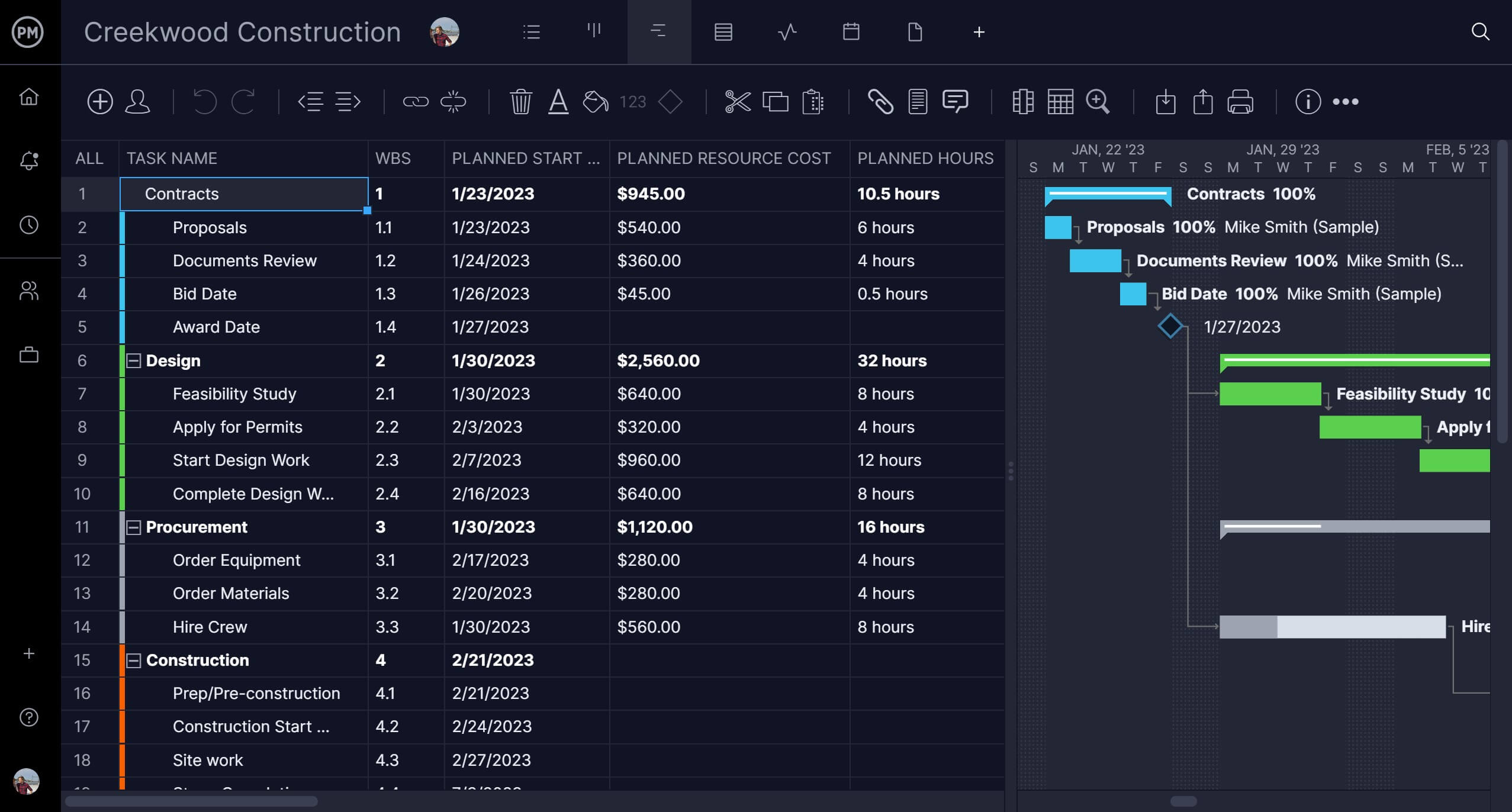Managing the workforce in a construction project is a complicated endeavor. There are so many different subcontractors and all have to work together to deliver the project on time and within budget. Resources in construction are managed by construction resource management.
There are many different types of construction resources beyond labor and we’ll define them as well as the process for construction resource management. We’ll even throw in a few free construction resource management templates to help you get started.
What Is Construction Resource Management?
Construction resource management is the process of planning and managing resources on a construction site. The purpose is to help those projects be delivered on time and within budget. This is the responsibility of construction managers or project managers, who monitor available resources, allocate and reallocate those resources based on the needs of the project and track and optimize their use.
The goal of construction resource management is to deliver successful projects as planned, but it does this by maximizing the utilization of resources and reducing waste. It works towards meeting the project’s objectives as efficiently and cost-effectively as possible.
This is greatly improved when using project management software, which is designed to make resource processes more efficient. ProjectManager is award-winning project management software with powerful resource management features that plan, manage and track resources in real time. Track resource utilization for every task with any of our multiple project views, such as Gantt charts, kanban boards or the list view. You can even use our secure timesheets to track labor costs. Get started with ProjectManager today for free.
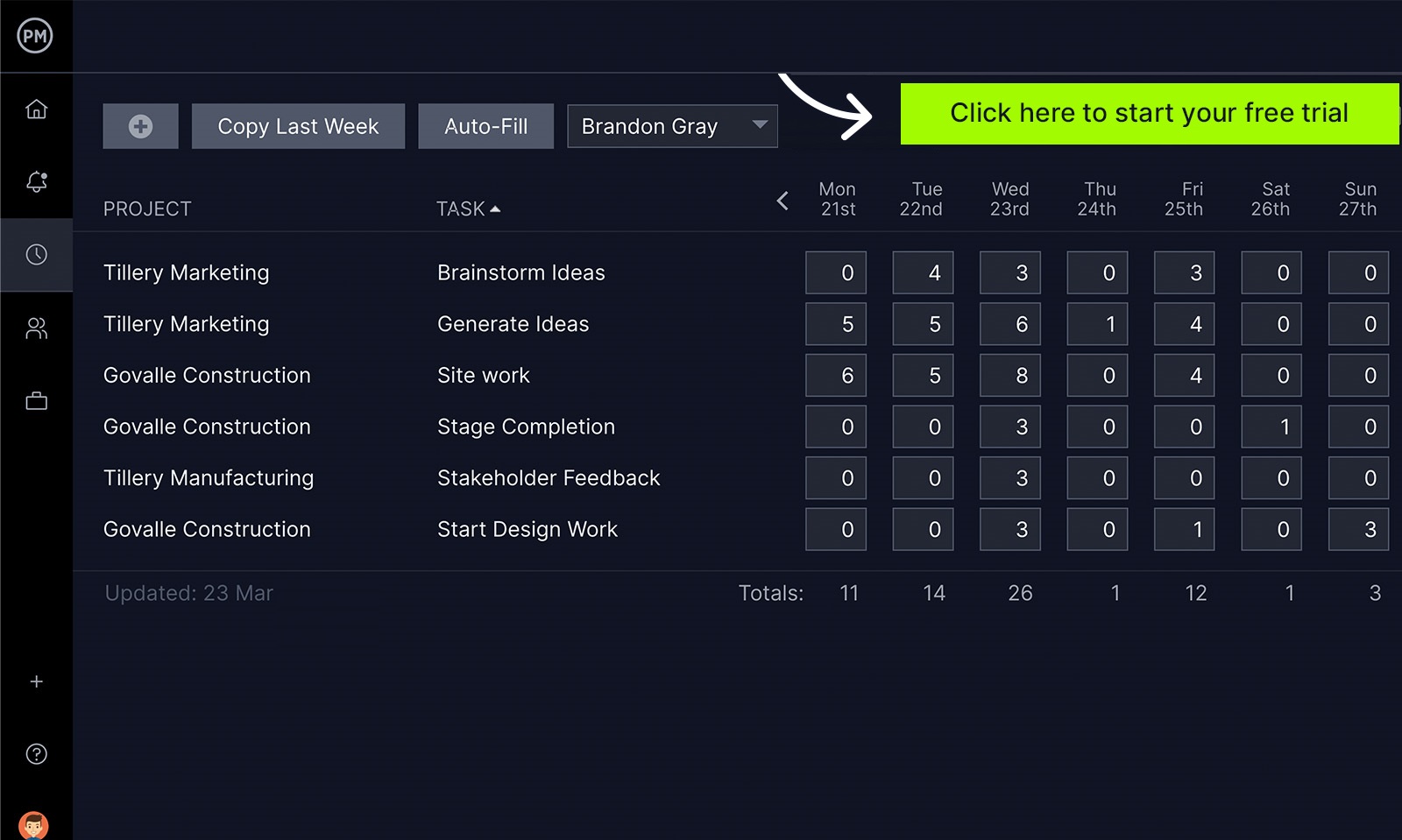
Types of Construction Resources
Resources are anything that’s used to execute the project or needed to bring the project to a successful completion. In the construction industry, there are many such resources used. The following is a list of them.
Raw Materials
Raw materials used in construction can be anything from wood, cement, metals, brick to concrete, clay and more. These are the most common materials, but there are many more. When selecting which materials to use, cost and quality are both going to play a significant role.
Equipment
Heavy equipment is used in construction. Which equipment is used for a construction project depends on the cost, but also the time involved in the construction. Some examples of equipment that’s found on a construction site include bulldozers, excavators, cranes, trenchers and more.
Labor
Labor is your workforce and human resources. It’s often said that these people are your most valuable resources as they’re the ones who use the other resources to execute the project. There are many types of labor on a construction site, including estimators, architects, supervisors, quantity surveyors, engineers and construction workers.
Facilities
Facilities improve the workforce’s welfare and improve efficiency. By regulation, construction sites must have living accommodations for workers, sanitary and toilet facilities, drinking water facilities, changing rooms and lockers and a canteen.
Financial Resources
Financial resources are the funds and assets that finance the construction project. This is money that buys materials, rents equipment and pays the workforce, among other things.
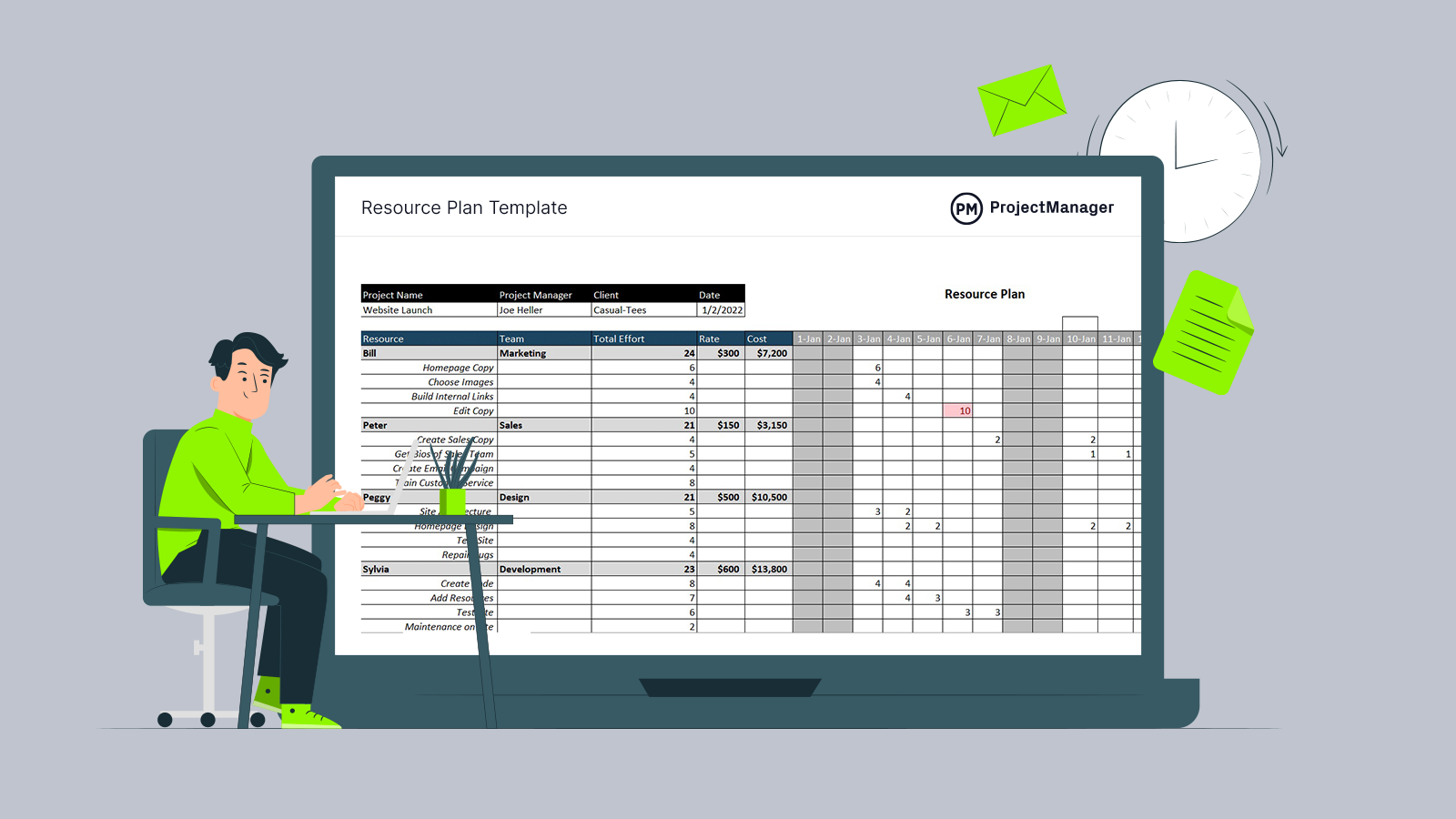
Get your free
Resource Planning Template
Use this free Resource Planning Template for Excel to manage your projects better.
Construction Resource Management Process
Having to manage all those resources requires a structured approach. Below is a step-by-step construction resource management process you can follow to ensure you have the right resources when you need them.
1. Conduct a Material Takeoff Analysis for Your Project
A material takeoff is a document that lists all the materials you’ll need for the construction project and the quantities for each. Construction drawings and plans inform the material takeoff. This is an important construction document that’s essential for the estimating and bidding process, but it also informs your resource needs.
2. Write a Scope of Work
Next, you need to create a scope of work. This differs from the material takeoff in that it’s a comprehensive list of the construction obligations and the work activities for everyone involved in the project, from contractors to subcontractors and suppliers. This is also used as an agreement or contract between all parties involved and is going to help define the resource requirements for the project.
3. Estimate the Costs of Labor, Materials and Equipment
With the material takeoff and the scope of work, you can now begin to forecast the cost of your resources for the project. Look at all the labor, materials, equipment, etc., required to execute the project and make as accurate an estimate as possible for each and add them up. This will be the start of your construction project budget.
4. Create a Construction Budget
With the information you’ve collected in the last step, you can now build a construction budget. You have an accurate estimate of the total costs of the project and now, as a general contractor, it’s your job to attach those costs to the tasks and a timeline to request the right amount of funds to complete the project. Be sure that your estimate is accurate and even a bit padded to cover unexpected expenses. If you go over the budget, it’s going to eat into your profit margin.

5. Acquire Resources and Begin Project Execution
Now that you know the resources required to complete your project and have estimated their costs, you’ll have to partner with suppliers and vendors to ensure that you have them when you need them throughout the execution of the project. Once these relationships have been established and scheduled, the execution of the project tasks can begin.
6. Allocate Resources and Track Resource Utilization
To ensure that you have the right resources at the right time, you need to allocate those resources. In terms of labor, it means knowing who’s available to work, and for nonhuman resources, it requires having contracted with suppliers and vendors. But planning and allocating resources is only the start. You need to track those resources as projects are notoriously in flux and things don’t always go as planned.
7. Monitor Project Costs and Keep Your Project Under Budget
Another reason to monitor your resources is to control costs and keep to your budget. You’ll need to ensure that your crew and subcontractors are keeping to the schedule that has been set and that suppliers and vendors are delivering materials as contractually agreed upon. This requires close monitoring of the project’s progress and performance, especially costs.
Resource Planning Template
Having a plan to ensure your resources are available when you need them is essential to construction resource management. This resource planning template for Excel helps you estimate what are all the different resources that will be needed to execute your construction project such as labor, materials or equipment and their costs, which is the first step before creating a construction estimate or a construction budget.
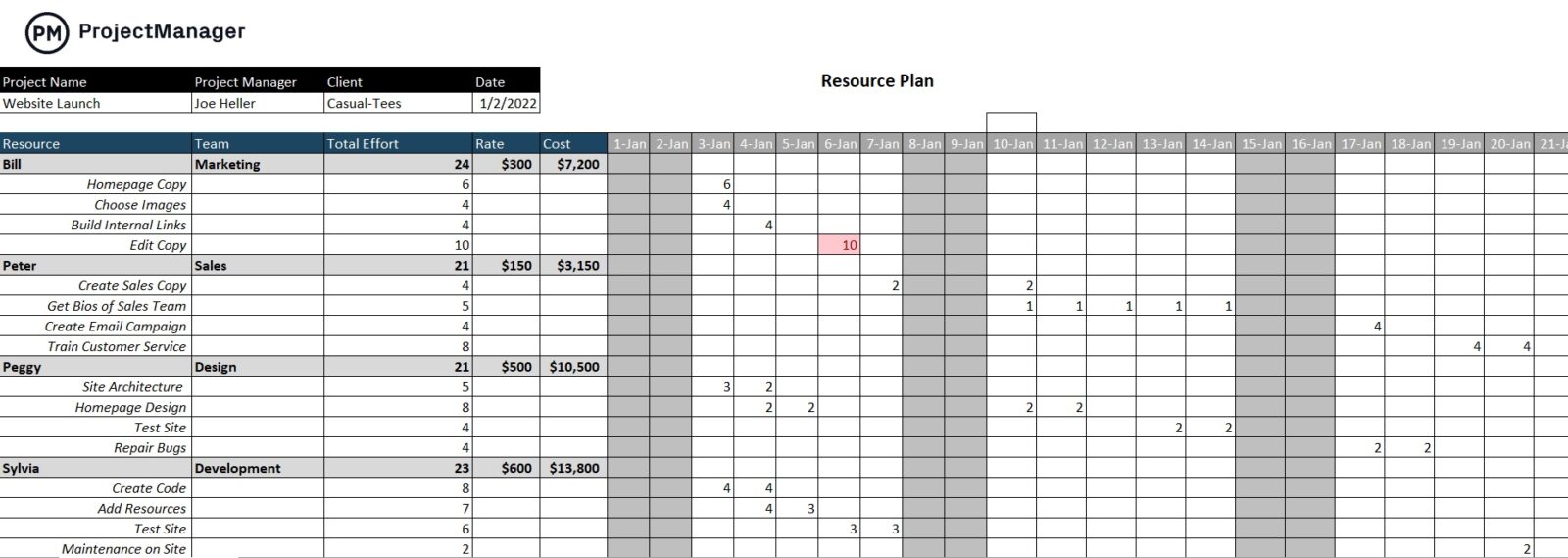
Construction Resource Management Templates
You know the process for construction resource management, but it also requires resource management tools. ProjectManager is a resource management software, but if you’re not ready to upgrade, we have dozens of free project management templates for Excel and Word that you can download right now. Here are some that have been designed specifically for construction resource management.
Scope of Work Template
Knowing the scope of your project is essential to construction resource management. Our free scope of work template for Word helps you define your project scope from describing the scope and outlining project deliverables to listing what is outside of the project’s scope.
Construction Estimate Template
Accurate estimates help with construction resource management and creating a budget. With our free construction estimate template for Excel, you can forecast labor and material costs as well as ensure your profit margin.
How ProjectManager Helps With Construction Resource Management
All those templates are a great way to prepare for your construction project. But once you’re in the execution and monitoring and controlling phases you’re going to need project management software. Templates are just static documents that have to be manually updated and are going to take time away from more important work. ProjectManager is award-winning construction project management software that helps you plan, manage and track resources in real time.
Create Construction Project Schedules and Budgets
Resources are attached to tasks, which have to be done in a certain order to meet the construction project’s deadline. Our robust Gantt charts help you organize your tasks and associated resources and costs to build a project schedule and budget. You can link all four types of task dependencies to avoid costly delays, filter for the critical path to identify essential tasks and set a baseline to track project variance in real time.

Allocate Resources and Manage Your Team’s Workload
Labor costs can bust your budget. You need to be able to allocate and track those resources. Our software allows you to see the availability of your team, including PTO and vacation time, which makes it easier to allocate resources. Then you can toggle over to the workload management chart. It’s color-coded so you can see your team’s allocation at a glance. Then you can reallocate the resources right from the chart to balance their workload and ensure they’re all working at capacity.
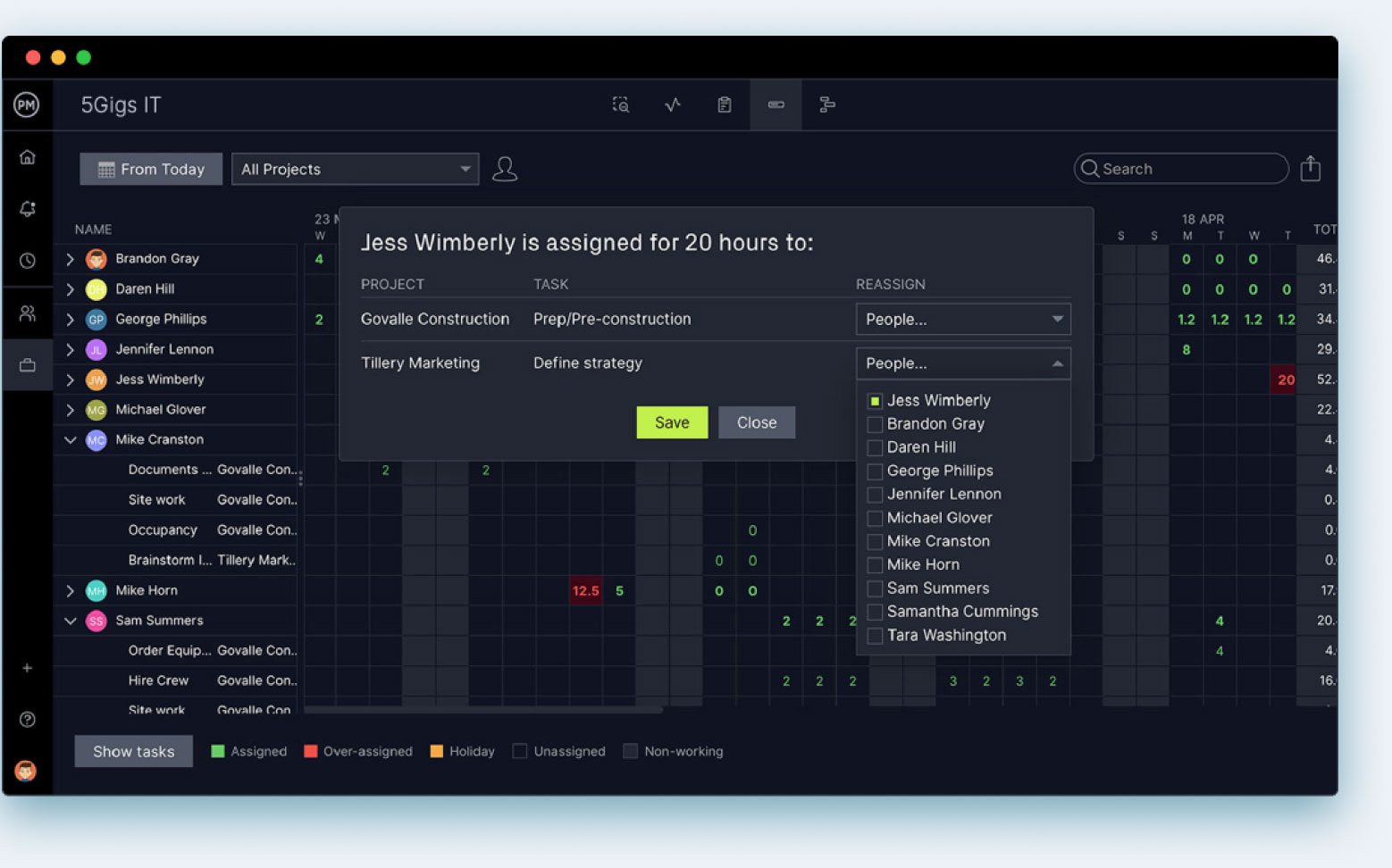
Other features can help you monitor your resources. We have a real-time dashboard that gives you a high-level overview of project metrics including cost, workload and more. For more detail, you can use our customizable reports, which can be filtered to show only the data you’re interested in. They can also be shared across a variety of formats to keep stakeholders updated.
ProjectManager is cloud-based construction project management software that connects teams whether they’re in the office, on the job site or anywhere else. They can share files, comment at the task level and stay updated with email notifications and in-app alerts. Get started with ProjectManager today for free.

